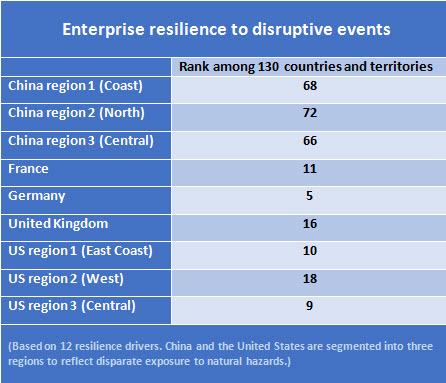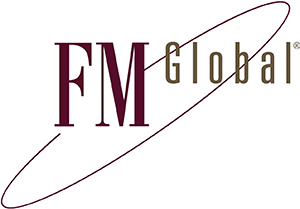Supply chain managers are being told that three of the most pressing risks to business performance in the 21st century are cyber attack, natural hazards and supply chain failure.
The 2017 FM Global Resilience Index, released today, provides SCMR readers with additional insights on emerging nations.
“The Index reveals some of the traits that make emerging markets both robust and risky. We conclude that each set of opportunities and risks are unique to each region,” says Brion Callori, Senior Vice President, Engineering and Research at FM Global.
Some examples:
Brazil is ranked 67 out of 130 countries and territories in the index. It scores reasonably well on natural hazard exposure and inherent cyber risk, but it's held back by its infrastructure, oil intensity and fire risk quality.
China's three regions are ranked 66, 68 and 72. As a whole, the country has been nudging up the rankings over the last five years due mainly to a steady improvement in the quality of its infrastructure.
India is ranked 60. It rises 13 places in this year's index due to improvements in supply chain visibility, infrastructure and natural hazard risk quality. With its growing information technology industry, it emerges as a country with below-average inherent cyber risk.
The Russian Federation ranks 57. It ranks well on natural hazard and fire risk quality, but it's held back by inherent cyber risk and political risk. Russia ranks below average in supply chain visibility – i.e., the ability to demonstrate where parts, components or products are in transit.
Thailand is ranked 97. It is exposed to flooding and in the bottom 10 for its high rate of urbanization. Together, these drivers can be a big threat to enterprise resilience.
The annual index, which is online and interactive, ranks 130 countries and territories by their enterprise resilience to disruptive events. Now in its fourth year, the index provides a unique resource to help business executives site facilities, select suppliers, evaluate established supply chains and identify customers who may be vulnerable.
For companies concerned by the increasing incidence of cyber attack, oil-rich Saudi Arabia has emerged as a country with above-average inherent cyber risk. Its high internet penetration, combined with a limited cyber security industry, make it a more vulnerable target. Developing India, by contrast, with its growing information technology industry, emerges as a country with below-average inherent cyber risk. (See the Infographic)
For companies aware of the heavy toll of natural disasters, Sweden has above-average resilience due, in part, to its lower-than-average exposure to hazards such as windstorms, flood and earthquakes. On the other hand, flood-prone Bangladesh, a major manufacturing hub for apparel and textiles, ranks toward the bottom of the index. (See the Infographic)
For companies with global supply chains, Germany, a major exporter and importer, ranks near the top in resilience, driven in part by its strong ability to demonstrate where parts, components or products are in transit. Russia ranks below average in this respect. (See the Infographic)
Users of the index can now investigate 12 quantified resilience drivers related to each country's economic strength, risk quality and supply chain condition.
The index also ranks countries in overall enterprise resilience. Wealthy Switzerland occupies the number-one ranking, reflecting high scores for its infrastructure, local supplier quality, political stability, control of corruption and economic productivity. Hurricane-ravaged Haiti ranks at the bottom of the index due in part to its high natural hazard exposure and poor economic conditions.
Many of the insights above originate from three new resilience drivers added to the index this year:
- Inherent cyber risk – Reflects a country's vulnerability to a cyber attack and its ability to recover.
- Urbanization rate – Serves as a proxy for stress (on water supplies, power grids and other infrastructure) that would be exacerbated by natural disasters such as windstorms, flood and earthquakes.
- Supply chain visibility – Reflects the ability to track and trace consignments across a country's supply chain.
Other drivers of resilience that form the index include: productivity, political risk, oil intensity, exposure to natural hazard, natural hazard risk quality, fire risk quality, control of corruption, quality of infrastructure and quality of local suppliers.

The index was produced for FM Global by analytics and advisory firm Pentland Analytics. Find index sources, methodology, graphics and video here.
SC
MR


Latest Supply Chain News
- Few executives believe their supply chains can respond quickly to disruptions
- Technology’s role in mending supply chain fragility after recent disruptions
- Tech investments bring revenue increases, survey finds
- Survey reveals strategies for addressing supply chain, logistics labor shortages
- Israel, Ukraine aid package to increase pressure on aerospace and defense supply chains
- More News
Latest Podcast

 Explore
Explore
Latest Supply Chain News
- Few executives believe their supply chains can respond quickly to disruptions
- Technology’s role in mending supply chain fragility after recent disruptions
- Tech investments bring revenue increases, survey finds
- Survey reveals strategies for addressing supply chain, logistics labor shortages
- Israel, Ukraine aid package to increase pressure on aerospace and defense supply chains
- How CPG brands can deliver on supplier diversity promises
- More latest news
Latest Resources

Subscribe

Supply Chain Management Review delivers the best industry content.

Editors’ Picks





